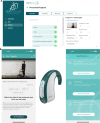Wearable sensor and smartphone assisted vestibular physical therapy for multiple sclerosis: usability and outcomes
- PMID: 39050817
- PMCID: PMC11267627
- DOI: 10.3389/fresc.2024.1406926
Wearable sensor and smartphone assisted vestibular physical therapy for multiple sclerosis: usability and outcomes
Abstract
Introduction: Vertigo, dizziness, gaze instability and disequilibrium are highly prevalent in people with MS (PwMS) and head movement induced dizziness is commonly reported. Vestibular physical therapy (VPT) is a specialised, non-invasive and effective therapy for these problems but usually involves travel for the person to a specialist center with both personal and carbon costs. The use of wearable sensors to track head movement and smartphone applications to deliver and track programs has potential to improve VPT in MS.
Methods: This study investigated the usability and effects of a commercially available digital VPT system (wearable head sensor, smartphone app and clinician software) to deliver VPT to PwMS. A pre/post treatment design was employed and the primary outcome was the System Usability Scale (SUS). Other patient reported outcomes were the Service User Acceptability Questionnaire (SUTAQ), the Patient Enablement Instrument (PEI) and the Dizziness Handicap Inventory (DHI). Physical outcomes measurements included Mini-BESTest (MB), Modified Dynamic Gait Index (mDGI), Gait Speed (GS), Dynamic Visual Acuity (DVA) and head kinematics and symptoms during exercise.
Results: Sixteen PwMS (14 female), mean age 44(±14) years were recruited to the study and twelve completed VPT. Mean adherence to exercise, measured digitally was 60% (±18.4). SUS scores were high at 81 (±14) and SUTAQ scores also demonstrated high levels of satisfaction and acceptability of the system. Statistically significant improvements in MB (mean change 2.25; p = 0.004), mDGI (median change 1.00; p = 0.008), DVA (median change -1.00; p = 0.004) were found. Head frequencies significantly improved with concurrent decreased intensity of dizziness during head movements (mean change across 4 gaze stabilization exercises was 23 beats per minute; p < 0.05). Non-significant improvements were seen in DHI (p = 0.07) and GS (p = 0.15). 64.5% of follow up visits were conducted remotely (video or phone), facilitated by the system.
Discussion: This study had two main outcomes and benefits for PwMS. Firstly, we showed that the system used was both acceptable and could be used by PwMS. Secondly, we demonstrated an improvement in a range of dizziness, balance and gait metrics with remotely delivered care. This system has the potential to positively impact on MS physiotherapy service provision with the potential to deliver effective remote care.
Keywords: disequilibrium; dizziness; multiple sclerosis; remote monitoring; vestibular rehabilitation.
© 2024 Meldrum, Kearney, Hutchinson, McCarthy and Quinn.
Conflict of interest statement
DM is the inventor of the digital intervention that was employed in the study. It is patent pending and DM is named on the patent. DM is a shareholder in Vertigenius, which is a Trinity College Dublin spinout company. The remaining authors declare that the research was conducted in the absence of any commercial or financial relationships that could be construed as a potential conflict of interest.
Figures




References
-
- International Federation of MS. (2024). Available online at: https://www.atlasofms.org/map/united-kingdom/epidemiology/number-of-peop... (accessed March 25, 2024)
-
- Zeigelboim BS, Arruda WO, Mangabeira-Albernaz PL, Iorio MC, Jurkiewicz AL, Martins-Bassetto J, et al. Vestibular findings in relapsing, remitting multiple sclerosis: a study of thirty patients. Int Tinnitus J. (2008) 14:139–45. - PubMed
LinkOut - more resources
Full Text Sources
Miscellaneous

